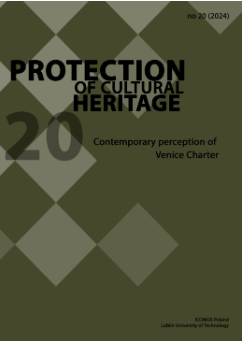Venice Charter and its role in shaping concepts in the heritage protection system
Siwek Andrzej
andrzej.siwek@uj.edu.plUniwersytet Jagielloński, Instytut Historii Sztuki (Poland)
https://orcid.org/0000-0002-3255-8768
Abstract
The Venice Charter is one of the fundamental doctrinal documents sharing the contemporary system of heritage protection. In its preamble and the articles regarding definitions, the essence of the statements defining the purpose of the heritage protection system has been
covered. It provides a rationale for why the heritage protection system should exist. It defines what
should be understood as heritage, and the articles defining the intention emphasizes that it is “to safeguard them no less as works of art than as historical evidence”. These concise yet comprehensive definitions form the foundation for further doctrinal considerations. Subsequent doctrinal documents and modern strategic papers contain numerous formulations which are addressing both the definition of the monument (as the object of protection) and the purpose of the activity. A notable trend is the broadening of the understanding of the term “monument” and
the expansion of justifications for the system's functioning. Monuments are preserved not only for cultural or historical reasons but also for economic, social, climatic, and other impacts. This process leads to a deconstruction of the heritage protection system, where in the definition of the object of protection, the values justifying the system’s existence, and its goals become increasingly ambiguous.
The perspective for the functioning of the heritage protection system requires a re-evaluation of its
assumptions and a return to basic concepts, which are explaining and guiding its existence. It is worth
considering, whether and how, under contemporary conditions, the basic definitions and principles
of the Venice Charter can be rearticulated to reinforce their relevance in shaping the rules of how the
system is operating. Without and updated definition of the monument and a clear articulation of the
purpose, its role will be taken over by other socio-economic activities. Consequently, conservation
concepts will be undergoing further modification, ultimately threatening the preservation of
resources and the established traditions of heritage protection.
Keywords:
heritage protection, Venice Charter, Conservation doctrine, historic monumentReferences
Bukowska W., Krawczyk J. (Eds.). (2015). Karta Wenecka 1964-2014. Toruń.
Google Scholar
Bullock N. (2002). Building the Post-War World. Londyn.
Google Scholar
Chlebowicz P. (2019). Działania ISIS wymierzone przeciwko światowemu dziedzictwu kulturowemu, Studia Prawnoustrojowe 43.
Google Scholar
Cultural heritage. https://culture.ec.europa.eu/pl/policies/selected-themes/cultural-heritage
Google Scholar
Cunliffe E. (2012). Damage to the soul: Syria’s cultural heritage in conflict. Durham.
Google Scholar
Czyż K. (2014). Karta Wenecka – eksperyment, który się nie powiódł, Gdańsk Strefa Prestiżu - Niezależny serwis Gdańska, Pomorza i okolic, 20 czerwca 2017; https://www.gdanskstrefa.com/eksperyment-ktory-sie-nie-powiodl/ [access: 1.07.2024].
Google Scholar
Damais J.-P. (1963). La Nouvelle Ville du Havre, reconstruction et population. Paryż.
Google Scholar
Kowalski K. (2017). Od zabytku do dyskursu. O kilku źródłach współczesnej definicji dziedzictwa, Prace Etnograficzne 45(1).
Google Scholar
Krasnowolski B. (2023). Ochrona zabytków: Historia, doktryny, systemy prawne. Kraków.
Google Scholar
Krawczyk J. (2006). Alois Riegl, Georg Dehio i kult zabytków. Warszawa.
Google Scholar
Krzyżanowski L. (1975). Karta Wenecka czy Karta Konserwacji Zabytków? Ochrona Zabytków 28/3-4(pp. 110-111).
Google Scholar
Lalewicz M. (1933). Sprawozdanie Międzynarodowej Konferencji zwołanej w roku 1931 Atenach w sprawie ochrony i konserwacji zabytków sztuki i historii, odczytane dn. 18 marca 1932r. na posiedzeniu Polskiej Komisji Międzynarodowej Współpracy Intelektualnej Warszawie,. Warszawa. https://polona.pl/item-view/ffb9cd96-6565-4c7e-9c95-c5d80c91ce20?page=2
Google Scholar
Pleskaczyńska – Chylińska M., Majewski P. (2013). Jan Zachwatowicz (1900 – 1983). Architekt. Warszawa: Zamek Królewski w Warszawie.
Google Scholar
Rekomendacja Warszawska w sprawie odbudowy i rekonstrukcji dziedzictwa kulturowego (2018). Warszawa.
Google Scholar
Rennie K. R. (2001). The Destruction and Recovery of Monte Cassino, 529-1964. Amsterdam.
Google Scholar
Spence B. (1962). Phoenix in Coventry. The building of Cathedral. Londyn.
Google Scholar
Szmygin B. (2000). Kształtowanie koncepcji zabytku i doktryny konserwatorskiej w Polsce XX wieku. Lublin.
Google Scholar
Szmygin B. (2023). Międzynarodowe teksty doktrynalne ochrony i konserwacji zabytków. Lublin – Warszawa.
Google Scholar
Szmygin B. (Red.) (2015).Vademecum Konserwatora Zabytków. Warszawa.
Google Scholar
Tomaszewski A. (2012). Ku nowej filozofii dziedzictwa. Kraków.
Google Scholar
Torczyńska M. (2019). Sztuczna inteligencja i jej społeczno-kulturowe implikacje w codziennym życiu, Kultura i Historia 36(2).
Google Scholar
Uchwała Nr 232/2022 Rady Ministrów dnia 23 listopada 2022 r. w sprawie ustanowienia Rządowego Programu Odbudowy Zabytków. https://www.gov.pl/web/premier/rzadowy-program-odbudowy-zabytkow
Google Scholar
Wojewódzki program opieki nad zabytkami Małopolsce na lata 2022–2025. Załącznik do uchwały Nr LVI/800/22 Sejmiku Województwa Małopolskiego dnia 4 lipca 2022 roku; https://www.malopolska.pl/_userfiles/uploads/kultura%20i%20dziedzictwo/Zabytki/WPONZ_2022-2025.pdf
Google Scholar
Wojewódzki Program Opieki nad Zabytkami województwie podkarpackim na lata 2022-2025 przyjęty Uchwałą Nr LVI/972/22 Sejmik Województwa Podkarpackiego 28 grudnia 2022 r. https://podkarpackie.pl/index.php/kultura/wojewodzki-program-opieki-nad-zabytkami/wponz-2022-2025
Google Scholar
Wojewódzki Program Opieki nad Zabytkami Województwa Zachodniopomorskiego na lata 2021-2024 przyjęty Uchwałą Nr XXIX/338/21 Sejmiku Województwa Zachodniopomorskiego dnia 28 października 2021 r.; http://eregion.wzp.pl/sites/default/files/zalacznik1.pdf
Google Scholar
Wójcicki H. (2023). Ciche ofiary wojny Ukrainie: Dziedzictwo kulturowe jego losy trakcie konfliktu, Kwartał 02(27).
Google Scholar
Zapłata R. (2016). Autentyzm zabytkowej architektury palimpsest przestrzeni historycznej – nowe media prezentacja dziedzictwa kulturowego, Architectus 1(45).Alois Riegl, Georg Dehio i kult zabytków, przekład i wstęp R. Kasperowicz, red. J. Krawczyk, Warszawa 2006.
Google Scholar
Authors
Siwek Andrzejandrzej.siwek@uj.edu.pl
Uniwersytet Jagielloński, Instytut Historii Sztuki Poland
https://orcid.org/0000-0002-3255-8768
Statistics
Abstract views: 20PDF downloads: 14 PDF downloads: 13









